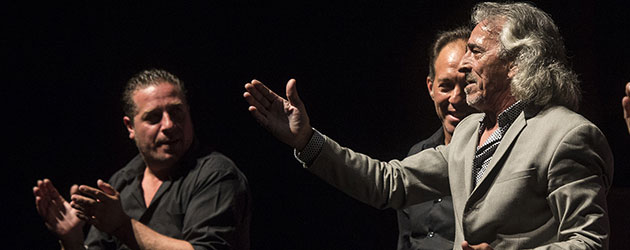Text: Silvia Cruz Lapeña
Photos: David Mudarra
In «De Bronce y Oro» there was good flamenco, but the three recitals of a half hour each bore no relation to each other, nor was there a choral moment to give unity to the show.
Antonio Reyes began “De Bronce y Oro” with Diego Amaya on guitar for Manolo Caracol’s “Pregones de la Uva”, and the audience on his side. He continued with siguiriya, then soleá which triggered the warmest ovation of his performance. He was feeling good and self-assured, and the people loved him. He ended with bulerías, and the audience was enthralled. In Madrid, the man from Chiclana followed the same line that has brought him such success: a mixture of inspiration and efficiency that is making him a regular on the flamenco circuit.
“My brother was injured in the mines” [‘Tengo un hermano en la mina / que malherío cayó’]…thus began Duquende, with his sombrero pulled down to his eyebrows, hidden and dark, and it was nearly the best thing of his repertoire. He did tangos and bulerías, but both were a bit dull. He sang well, getting into himself now and again, but even the guitarist Paco Heredia seemed to be wary of showing too much emotion. You have the feeling that Duquende is applauded now more for who he was than who he is, although it’s true there were some moments when it seemed we were going to see the singer he used to be.
Capullo de Jerez was up next, with his war cry vocalization, and he almost got the audience dancing from the first moment. He did bulería por soleá, fandangos that were nearly recited, tangos, bulerías and his classic ending dedicated to the Real Madrid soccer team, his favorite, and he sang showing what he really is: a showman. Capullo is a performer with no complexes, he knows what the audience wants and gives it to them shamelessly and without excuses. He was accompanied by Manuel Jero on guitar, and the man was up to the task, full of swagger like the singer he was accompanying.
The explanation on the program about what “De Bronce y Oro” was going to be, was intricate, but in actual fact it’s easy to explain: three singers, each one doing his own thing for a half hour. It’s not that it was too little, because there were some moments of good flamenco, but whoever dreamt up the idea seriously needs to reconsider the format. The Sala Roja is a venue for presenting a show, and “De Bronce y Oro” wasn’t three recitals (a half hour is too short to be a recital), nor was it a show. With simply having chosen a different venue, the package would have gone down better. Either that, or having announced three independent recitals, because there was no connection or motif, not even a moment in which the three came together to give unity to the show.
